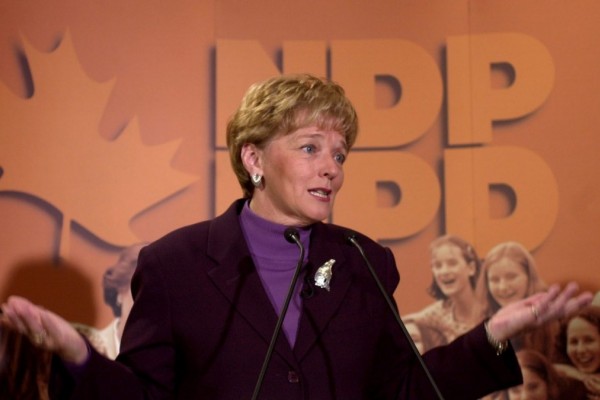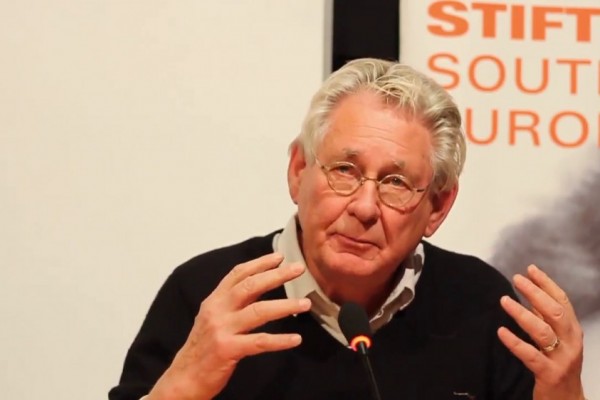The little-known Ontario tribunal standing in the way of defunding the police
On the limits of democracy within the Canadian state

A recent Ipsos poll showed 51 percent of Canadians support defunding the police, and yet there is no means by which this can be translated into policy in Ontario. Photo by Bobb Barratt/OPP/Flickr.
The police murder of George Floyd in May of this year sparked what is likely the largest mass movement in American history. Affirming the value of Black lives and protesting against police brutality, the movement has increasingly coalesced around demands to defund or abolish the police. This movement has not been limited to the United States—numerous rallies and calls to defund police services in Canada have also occurred over the course of the summer.
It is well known that the political left is engaged in efforts to advocate for the defunding or abolishment of police forces across the country. What is less clear is how that could occur procedurally. Here, I will seek to explore the process and pitfalls of defunding the police in Ontario, showing that ultimately the police as an institution are largely removed from any meaningful form of democratic oversight. As a result, defunding the police in the province will be exceptionally difficult within the confines of Ontario’s current institutional framework, revealing the limits of democracy within the Canadian state.
The institutional framework of policing in Ontario
Due to the nature of its federalist system, Canada has what is called a tripartite policing framework. The Royal Canadian Mounted Police (RCMP) operates at the federal level for issues under federal jurisdiction. All other policing is left, according to the Constitution, to the provinces.
Some provinces–Ontario among them—have a provincial police force. Most provinces, however, devolve the responsibility, if not the control, for policing to municipalities. Ontario does this as well, allowing for the creation of municipal police forces. The question of defunding the police at the federal and provincial level is fairly simple: the federal and provincial governments set the police budget as part of their broader budgets, and it is the legislature which has the power to approve or reject budgets. Yet, for municipal police, at least in Ontario, the question is a good deal more complicated.
In Ontario, municipal councils have virtually no control over municipal police forces. The arms-length relationship between the police and the municipalities they purport to serve has its origins in the institutional arrangements which existed pre-Confederation. Attempting to shape the police into a modern state institution, rather than one dominated by patronage appointments, the government of Upper Canada created the first Board of Commissioners of Police in 1858. These boards were responsible for the administration of urban policing and were supposed to be free from direct political interference of municipal officials. After Confederation, when policing powers were granted to the provinces, this arrangement was maintained. Today in Ontario, these bodies are known as police services boards, and are justified under the common law principle of police independence.
The composition of police services boards is set out in the Police Services Act, 1990. Depending on the size of the municipality in question, police services boards are to be composed of three, five, or seven members. Generally speaking, the head of a municipal council (the mayor) sits on the police services board, alongside other delegates from the municipal council, appointees from the Lieutenant Governor, and sometimes citizens who are neither councilors nor city employees. Police services boards are responsible for the administration of police forces, but are explicitly prohibited from intervening in the day-to-day operations of police forces. It is the police services boards which are responsible, in consultation with chiefs of police, for proposing the police budget.
While municipalities do not control police forces, they are still obligated to pay for them. Municipal councils have the power to approve or reject police budgets. However, if a municipality rejects a proposed police budget, the police services board has the ability, under Section 39 of the Police Services Act, to appeal to the Ontario Civilian Police Commission (OCPC). The OCPC then becomes the ultimate arbiter of the police budget, with both the city and the police services board presenting their respective cases before a tribunal.
What is the Ontario Civilian Police Commission?
The OCPC “is an independent, quasi-judicial agency” with a broad and somewhat strange mandate. It is one of Ontario’s three civilian police oversight bodies, the other two being the Special Investigations Unit (SIU), and the Office of the Independent Police Review Director. The OCPC is composed of both an Adjudicative Division and an Investigative Division. OCPC tribunals hear a wide range of issues including appeals of police disciplinary penalties; requests to abolish, create, reduce, or amalgamate police services; the associational status of police service members; issues relating to the adequacy and effectiveness of policing services; and disputes between municipalities and police services boards over budgets. The OCPC also has the power to investigate police chiefs, police services, and police services boards if they are believed to have engaged in improper conduct.
The origins of the OCPC can be traced back to 1962 when the Ontario Police Commission was created as a “general watch-dog role over law observance and enforcement in Ontario.” Shortly after, it was given the power to review municipal budgets. The demand for civilian oversight of policing was closely related to the struggles of the 1960s and 1970s, especially around civil rights and racial equality. In 1977, the Ontario Civilian Commission on Police Services was given the task of receiving public complaints about the police. In 1990 the SIU was created in response to increased backlash over police killings, and the SIU’s investigate powers were stripped from the Police Commission. The Police Services Act renamed the Commission to the Ontario Civilian Commission on Police Services and further stripped its ability to hear public complaints, which became the responsibility of a Police Complaints Commissioner.
In turn, in 2007, legislation was passed to create an independent public complaints oversight body—the Office of the Independent Police Review Director—which came into being in 2009. It was at this time that the Ontario Civilian Commission on Police Services was renamed the Ontario Civilian Police Commission; that it has a strange assemblage of responsibilities is a result of specific responsibilities being carved off of it since its creation as new state apparatuses were created in response to struggles against police abuses.
Meeting of the North Western Ontario Police Services Boards, October 10, 2019. Photo from Twitter.
Who sits on the OCPC?
Members of the OCPC are appointed by the Lieutenant Governor for a defined term, though no term limits exist. Since 1990, there have been 70 different members appointed to the OCPC and its predecessor body. 60 percent have been lawyers (two were prosecutors), and three have been judges. The percentage of appointees with legal backgrounds has increased considerably. In 1994, for instance, three of eight members were lawyers, compared to 21 of 23 in 2018. Four were also former police officers. 41 percent have sat on other government boards or tribunals, with 20 percent sitting on other tribunals within the Safety, Licensing Appeals and Standards Division (SLASTO) cluster of tribunals (this is not particularly surprising given the government’s stated policy of cross-posting between clustered tribunals).
In terms of class background, the members of the OCPC are largely drawn from segments of the population that could be considered the elite. 34 percent are owners of firms including many legal practices. There is also a preponderance of upper managers on the OCPC. 64 percent of members have either sat on other NGO or charity boards, or have filled senior positions at private organizations including charities. 23 percent have either sat on a corporate board or held a corporate upper management position, and 13 percent have held public sector management positions.
That there is so much overlap between key government posts and director positions points to the existence of an interlocking directorate among the capitalist class that links with the executive of the Canadian state. Members of the OCPC include a member of the Canadian Club of Toronto, the CEO of Canada’s largest law firm, a former national Vice President of the federal Conservative Party, the chair of the Stratford Shakespeare Festival, and members of various local chambers of commerce. In fact, since 1990 only two members of the OCPC can be said to have had their roots within the workers’ movement: one a union organizer and the other a staff representative from the United Steel Workers. It is no surprise, then, that when looking at political support (determined by publicly standing as a candidate or political donations), while 61 percent had no public political affiliation, on the federal level 16 percent supported conservative political organizations, 16 percent supported the Liberal Party, while only four percent supported the NDP. Provincially, 11 percent each supported the Progressive Conservatives or the Ontario Liberal Party.
How are members of the OCPC chosen? In the past, OCPC appointees, like all tribunals, were appointed for a number of reasons—indeed, the federal government took the position that “each order-in-council appointment was a separate matter to be considered on its own merits.” Despite the constitutional principle of bureaucratic independence, appointments to tribunals were often the result of political patronage, either as a reward for party support or to ensure ideological cohesion within the civil service.
In 2003, the Ontario Liberals implemented a policy whereby all tribunal appointments had to be publicly advertised. In 2009, the Adjudicative Tribunals Accountability, Governance and Appointments Act stipulated that all appointments were to be the result of a “competitive, merit-based process” in which “experience and knowledge of the specific area of adjudication, aptitude for impartial adjudication, and aptitude for applying alternative adjudicative processes were to be the main criteria.”
Furthermore, while the Lieutenant Governor still ultimately decides the appointees to the OCPC, all tribunal appointments now require the recommendation of the chair of the tribunal. As of 2011, the competitive process can be waived for cross-appointments, or if the tribunal has an inadequate number of members. The Government of Ontario is explicit that appointees should be “representative of all segments of Ontario society.” However, appointments still happen without any democratic oversight, aside from an interview conducted by the Standing Committee on Government Agencies.
The fact that members of the OCPC are drawn disproportionately from the capitalist and professional classes—hardly “representative of all segments of Ontario society”—raises some immediate concerns, especially considering the OCPC is supposed to act within the framework of the “public interest,” and that appointments to the body happen largely without any democratic oversight. Those who benefit from the current order are more likely to have a favourable view of police because the police help maintain the current order. In this case, members of the elite sit on a tribunal which makes decisions about the maintenance of a service that the tribunal members disproportionately benefit from. That the OCPC, because it is quasi-judicial, is supposed to act within the principles of so-called natural justice and interpret the law in a manner free from bias makes blatantly clear that the definition of bias in a class society does not include the implicit bias of protecting the existing order.
The mode of practice of the OCPC
It is not just the social composition of the OCPC membership which limits the possibility of defunding or abolishing the police through official channels. Rather, the established modes of practice of the OCPC also prevent any meaningful reform.
The Public Accountability Documents, produced by the OCPC in line with the demands of the Adjudicative Tribunals Accountability, Governance and Appointments Act, provide insight into how the OCPC sees itself. OCPC members are bound to “conduct themselves… in a manner consistent with the nature of their responsibilities and the maintenance of public confidence in the administration of justice.” Approaching their work with an understanding of the injustice inherent in Canada’s current model of policing contravenes this point.
The expected competencies of members of the OCPC include expertise in policing legislation, an understanding of natural justice, and explicit instructions to search for mutual interest in cases of conflict. Attempting to meet the first two competencies means that OCPC members will largely be lawyers; this has been precisely the case after 2009 and can be seen as part of a broader trend towards neoliberal technocracy within the Canadian state.
Looking at the OCPC’s mode of practice, perhaps most egregious is the instruction that the Vice Chairs and Chair of the OCPC actively build relationships with so-called “stakeholders.” Who are counted among this group? The Public Accountability Documents list the Minister of Community Safety and Correction Services, the Ministry of Community Safety and Correctional Services, the Ontario Association of Chiefs of Police, the Ontario Association of Police Services Boards, the chairs of all municipal Police Services Boards in Ontario, all Ontario chiefs of police, the Police Association of Ontario, the presidents of all police associations of municipal police services in Ontario, the presidents of all senior officers associations of municipal police associations in Ontario, the Director of the SIU, the Ontario Independence Police Review Director, the Director of the Ontario Police College, and lawyers appearing frequently before the OCPC.
These stakeholders are also given preferential status when considering changes to the operations of the OCPC. Absent is the public at large, any representation on behalf of working class organizations, nor any of the communities disproportionately impacted by policing—namely, Black and Indigenous peoples.
Photo courtesy of the
Office of the Independent Police Review Director
OCPC tribunal decisions
The political orientation of the OCPC can be seen in the nature of its decisions. As mentioned above, when there is a disagreement between a police services board and a municipal council over a police budget, the police services board is able to appeal to the OCPC under Section 39 of the Police Services Act. While more often than not city councils in Ontario eagerly agree to the budgetary demands of the police, this is not always the case. There have been a handful of budget disputes between police services boards and their respective municipalities in recent years. When examined, a startling pattern emerges: police services boards frequently use the threat of an OCPC intervention to get their budget proposals approved.
For instance, in 2008 there was a three-way disagreement between the Niagara Police Services Board, the Niagara police chief, and the Niagara region’s municipal council. The police services board threatened to go to the OCPC in the local media. Ultimately, a settlement was reached through OCPC mediation before an OCPC decision could be made. In 2011, Hamilton City Council sent the proposed budget, a five percent increase over 2010, back to the police services board for reconsideration. The police services board refused, and threatened to take the council to the OCPC. City council subsequently approved the budget.
Later, in 2016, London City Council refused to pay for the hiring of six additional positions within the London Police Service. The police services board appealed to the OCPC, reaching a settlement that resulted in the city agreeing to pay for the positions, albeit at an amount less than was initially requested.
Just this year in Toronto the threat of an OCPC intervention was used to attack attempts at defunding the police brought to Toronto City Council. These attempts ultimately failed.
In the history of the OCPC and its precursor bodies, there has only been one instance where a Section 39 decision was made. In 1999, the City of Guelph and the Guelph Police Services Board were unable to reach an agreement on the proposed police budget. The police requested $252,000 more than the municipal government was willing to approve to hire more court and traffic officers, pay for new uniforms, and complete Y2K-proofing of the department, among other measures. In the end, the OCPC mandated that Guelph city council pay $187,750 of the disputed funds.
That the OCPC sided with the police in the only budgetary dispute in Ontario history that invoked Section 39 is not surprising, and is clearly used by police services boards as leverage over city councils.
It should be noted that in each of the disputes discussed above, it was not defunding but rather the degree to which there would be a funding increase that was in contention. The OCPC sided with police even when arguments for a more limited funding increase came from a place of fiscal restraint rather than, say, a critique of the institution of policing itself.
Abolishing the police?
The OCPC has the power to create, amalgamate, reduce, and abolish police services, as outlined in the Police Services Act. In fact, the OCPC has used its power to abolish several police forces in the past: Orangeville (2020), Wingham (2018), Espanola (2018), West Nipissing (2018), Amherstburg (2018), Midland (2018), Pembroke (2013), and Perth (2013). However, in each of these cases, policing responsibilities were taken over by the Ontario Provincial Police, largely due to the inability of these smaller municipalities to continue paying the cost of running their own police services.
Indeed, the OCPC’s interpretation of the Police Services Act highlights that all municipalities are required to provide “adequate and effective police services,” which includes crime prevention, law enforcement, assistance to victims of crime, public order maintenance, and emergency response. When considering whether a police service can be abolished, the OCPC needs to be assured that there will still be an adequate and effective level of policing in the municipality in question. Adequacy is generally framed in terms of staffing levels and officer workload, rather than in reference to the actual rate and severity of crimes.
In a review of past OCPC cases, little consideration was given to the possibility of other services “adequately” taking over responsibilities from the police. It is worth noting that adequacy is also the standard by which budget disputes are also judged; for example, will the police service in question be able to adequately provide its services if it does not get the budget that it requests? Thus, it seems unlikely, given the provisions of the Police Services Act and the OCPC’s interpretation of that piece of legislation, that the OCPC would even entertain arguments around abolition coming from perspectives critical of the police as an institution.
Protesters at Queen’s Park calling for police divestment, Toronto, June 6, 2020. Photo by Michael Swan/Flickr.
OCPC control over police services boards
That the OCPC is a barrier to defunding or abolishing the police, as seen in its composition, practices, and history of decisions, is clear. But what about the police services boards themselves? Suppose that somehow, despite the provincial government having considerable say in precisely who gets to sit on police services boards (in a context where all major political parties support increased police funding), a pro-defund majority was able to establish itself on a police services board. If this hypothetical board were to propose a budget cut to the police, in agreement with city council, presumably there would be no grounds for an appeal to the OCPC under Section 39 of the Police Services Act. That a police services board with a pro-defunding orientation would even be allowed to exist is unlikely—here again we can turn to the past practices of the OCPC and its ability, under Section 23 of the Police Services Act, to remove members from police services boards.
The OCPC has used this power in the past, such as when it removed the mayor of Peterborough from the local police services board in 2015. A more egregious example, however, was the removal of Greg Oliver from the Stirling-Rawdon Police Services Board in 2014. Oliver, the chair of the board, had a long-standing conflict with the local chief of police. In a discussion around the police budget, Oliver said that he would “oppose any additional officers for the police department.” The OCPC ruled that declaring a hiring freeze was “not appropriate” because it “was essentially shutting down any dialogue around any needs of [sic] the Service may have in the future.” Oliver’s statement contravened the Members of Police Services Boards Code of Conduct both because it was an inflammatory statement, but also because it interfered with “the recruitment and promotion of police officers.”
Indeed, members of police services boards are prohibited from “engaging in conduct that would discredit or compromise the integrity of the board or police force,” effectively giving the OCPC authority to remove anyone critical of the police.
The OCPC and democracy
The OCPC forms, fundamentally, a “check and balance” on the possibility for democratic intervention into the existence or functioning of the police. It is part of a broader apparatus of police oversight that was intended to affirm the “independence” of police in Canada. This independence is not independence from the underlying structure of Canadian society, but rather independence from political attempts to shape how police act.
The OCPC is staffed by elites who benefit from policing, and its practices are designed to maintain the status quo. Its decisions reflect its composition and purpose. Furthermore, it has the power to remove people from police services boards, thus preventing other state institutions from attempting to exercise control over the police. It is buttressed by a Police Services Act, which effectively requires the maintenance of the status quo when it comes to policing due to provisions related to “adequacy.” The result is that the police in Ontario, a major coercive force of the state, are virtually insulated from any meaningful democratic pressures. A recent Ipsos poll showed 51 percent of Canadians support defunding the police, and yet there is no means by which this can be translated into policy in Ontario.
Why is this the case? The Canadian state is fundamentally a state of the ruling capitalist class, existing to ensure the continuation of the conditions of exploitation. While specific struggles have resulted in what can be considered limited democratic gains, these gains are always limited to specific state apparatuses, and are generally themselves limited in nature. Furthermore, those apparatuses which are central to the continuation of exploitation are further insulated from democratic pressures. The police, insofar as they represent the state’s ability to use force and coercion to maintain the existing order—in the form of criminalizing dissent, breaking strikes, protecting property, and so on—are particularly important for the maintenance of Canadian capitalism, imperialism, and colonialism. They are thus insulated from democratic pressures through an elaborate and convoluted system of “checks and balances.” These checks and balances, or even just aspects of Canadian society taken out of the control of the legislature, exist across the Canadian state, prohibiting meaningful change from within state institutions.
What would it take to defund the police in Ontario within the current institutional framework? It would take sympathetic police services boards, city councils, and the OCPC to agree on defunding. The police services boards would have to agree not to appeal to the OCPC over funding cuts, and would have to come to an agreement with their respective city councils over defunding demands. The OCPC would have to allow police services boards to operate in a manner contrary to their current code of conduct. In turn, a sympathetic OCPC would require that the existing OCPC be completely gutted; a new framework of practice, new members with different social origins, and the amendment or abolition of the Police Services Act to uphold the new practices would be necessary. This would require a sympathetic provincial government with the ability and political will to deeply alter fundamental provincial institutions.
None of this is very likely, however, within the current institutional framework that exists in Ontario. While the demands to defund and abolish the police are unquestionably correct for those seeking a more just and equitable society—and mass movements could compel the existing state to act in a way contrary to its desires and interests—at a certain point one has to wonder: wouldn’t it just be easier to overthrow everything and start from scratch, building state apparatuses and institutions which truly work for the people?
Martin Schoots-McAlpine is an organizer, communist, and a PhD candidate at York University. His research focuses on the history of the communist movement in Canada and abroad, as well as the modern Canadian state and its ties to capital.










